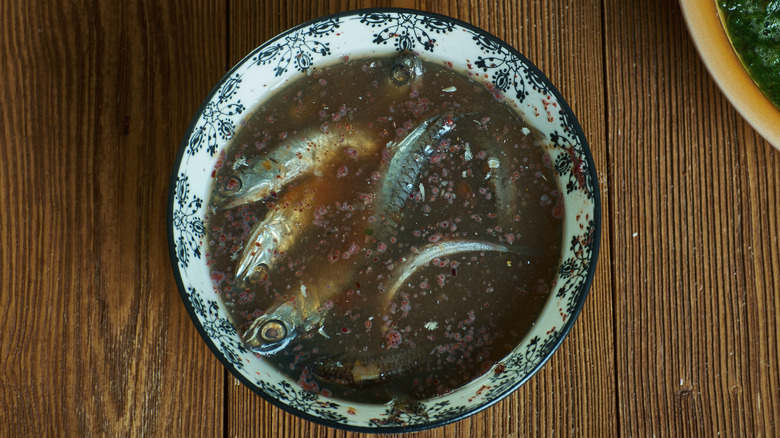How The First Preserved Anchovies Led To The Invention Of Fish Sauce
Seafood is divisive. Some love the buttery bite of crustaceans, the delicious richness of wild salmon, the briny mouthfeel of fresh-shucked oysters, and so on. Others feel such a profound revulsion toward eating creatures of the water that they steer clear of the surf and stick with the turf, almost religiously. Alternative seafood is also an upcoming trend, powered by vegans and people pursuing a more sustainable lifestyle.
If you're a seafood lover, then you surely know that there are gradients to that taste. Some people tend to favor the mild side, preferring a filet of cod or haddock to something with more pronounced flavors. Yet others crave the bold, unique, and at-times funky flavors that come from seafood. Think of oily mackerel sashimi, chewy, salty anchovies (which are different from sardines), and potent fish sauce.
As a matter of fact, anchovies and fish sauce have more than a little in common. The relationship between the two ingredients dates back to ancient times.
The first known form of fish sauce was a liquid byproduct that formed when the Greeks fermented their haul of small fishes with salt in order to preserve them (via World History Encyclopedia). Serious Eats suggests the type of fish used in this process was the anchovy. The Romans, who adopted the salting method, strained and fermented liquamen — the liquid that was drawn out from the anchovies — to create garum, a term for fish sauce.
Ancient fish sauce, lost and found
It bears mentioning that garum was not always made exclusively with anchovies. People in ancient Rome made fish sauce from a number of different sea creatures — anything from oysters and sea urchins to mackerel and herring — and frequently threw in all the parts, inclusive of the head, blood, and organs.
They also made other related garum products: muria (a brine that came from salting tuna), allec (a paste-like mix of bones and other sediments left from the fish), and haimation (a high-end luxury fish sauce commonly made from the innards and blood of tuna).
As much as garum in all its forms was prized by the Romans, little was actually known about how it was produced and how it tasted until recently. According to Smithsonian Magazine, researchers had uncovered garum production vessels throughout what was once the Roman Empire, but any residue that could be analyzed to figure out a recipe had deteriorated long ago.
That is, until a 2009 excavation in the ruins of Pompeii led to the discovery of a garum shop that housed six sealed containers of what is believed to be the ancient fish sauce. Experts have managed to reproduce it, using what they've learned from these remains as well as a third-century liquamen recipe comprised of fish, salt, and dried herbs like dill and fennel.

